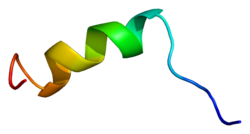Top Qs
Timeline
Chat
Perspective
SCN2A
Protein-coding gene in the species Homo sapiens From Wikipedia, the free encyclopedia
Remove ads
Sodium channel protein type 2 subunit alpha, also known as Nav1.2, is an ion channel protein encoded by the SCN2A gene in humans.[5] It represents one member of the sodium channel alpha subunit gene family. The SCN2A gene is located on chromosome 2 (2q24.3) in proximity to two other voltage-gated sodium channel genes, namely SCN1A and SCN9A.[6] Nav1.2 is distributed throughout the human central nervous system where it plays a major role in the initiation and propagation of action potentials. It is absent from peripheral tissues.[6] Pathologic mutations in the SCN2A gene cause a broad spectrum of neurological conditions, such as epilepsy, autism spectrum disorder (ASD), intellectual disability (ID) and/or developmental delay, called SCN2A-related disorders.[7]
Remove ads
Structure
The SCN2A gene is composed of 27 exons and comprises more than 150 kilobases. There are two major splice variants known, a neonatal isoform and an adult isoform, which differ in one amino acid at position 209 (Asn versus Asp).[6] The neonatal isoform might limit neuronal excitability during development.[7]: 23 The voltage-gated sodium channel Nav1.2 encoded by the SCN2A gene consists of 2005 amino acids.[6] This single polypeptide forms a pseudotetrameric channel of four similar domains (I - IV) where each domain contains 6 transmembrane segments, including a voltage sensing region, a pore forming region and an ion-selectivity filter.[8] In the living organism, Nav1.2 is a transmembrane glycoprotein complex composed of a large alpha subunit (encoded by the SCN2A gene) and one or more regulatory beta subunits (encoded by SCNxB genes).[9]
Remove ads
Function
Summarize
Perspective
The principal function of Nav1.2, similar to other members of the voltage-gated sodium channel family, is to mediate sodium influx into neurons upon membrane depolarization, thereby generating and propagating action potentials across distinct neuronal subtypes.[6]
Nav1.2 functions mainly in excitatory neurons in cortical structures similar to Nav1.6,[6] whereas expression of Nav1.1 (encoded by the SCN1A gene) is found in mutual distinct, inhibitory neuronal classes.[10] However, the distribution of Nav1.2 changes during development. Nav1.2 channels are initially expressed at the axon initial segments (the site of action potential initiation) of excitatory pyramidal cells in both hippocampal and cortical excitatory cells. While these levels remain constant in the hippocampus, in cortical excitatory cells, Nav1.2 becomes restricted to the portion of the axon initial segment closest to the cell body[6] and in dendrites[7] at the age of 1–2 years in humans. Nav1.6 gradually becomes the predominant channel type at the distal axon initial segment and axonal nodes of Ranvier. In mature neurons, Nav1.2 is distributed only throughout unmyelinated axons.[7] In contrast, its expression pattern in the cerebellum seems to persist throughout development, suggesting distinct roles for Nav1.2 in mature neurons of the neocortex and cerebellum.[6] When Nav1.6 takes over the initiation of action potentials, Nav1.2 might play a crucial role in driving their backpropagation into dendrites. This backpropagation could impact activity-dependent processes such as synaptic maturation, plasticity, and gene transcription.[6][7]
The activity of Nav1.2 is influenced by several factors, such as protein-protein interactions, posttranslational modifications (e.g. phosphorylation, pamitoylation), and changes in intracellular Ca2+ concentration.[7]
Remove ads
Clinical significance
Mutations in the SCN2A gene can cause a broad spectrum of disorders collectively referred to as SCN2A-related disorders. These include cases of ASD,[6] self-limited epilepsy, early infantile developmental and epileptic encephalopathy, later onset developmental and epileptic encephalopathy, infantile spasms, SCN2A-related disorders without epilepsy, episodic ataxia, and further movement disorders.[7] Two major groups of SCN2A mutations can be distinguished based on their functional consequences and response to seizure medication: gain of function mutations, typically associated with seizure onset within the first three months of life, and loss of function mutations, in which seizures begin after the first three months or may never occur. The former group tends to benefit from treatment with sodium channel blockers, whereas in the latter, such treatment is often ineffective or may even exacerbate seizures.[11] Notably, SCN2A is known to be the most prominent genetic risk factor for autism-spectrum-disorders.[6]
SCN2A gene mutations have also been identified in bitemporal glucose hypometabolism,[12] and bipolar disorder.[13]
See also
- paralytic - SCN2A ortholog in Drosophila
References
Further reading
External links
Wikiwand - on
Seamless Wikipedia browsing. On steroids.
Remove ads






